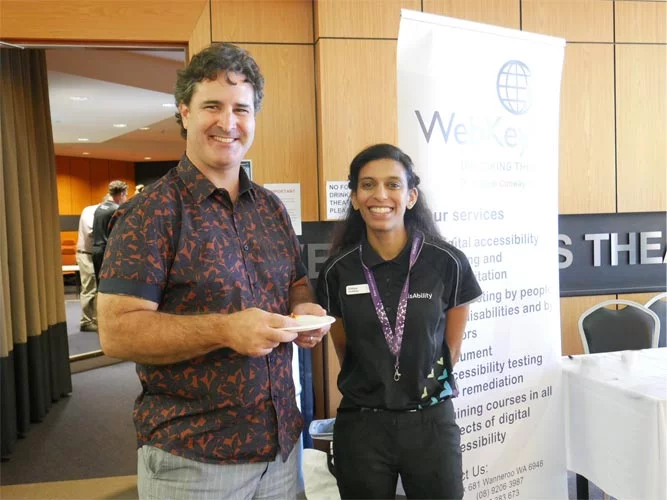
The Web Accessibility Camp also included a presentation by our own Accessibility Specialists Vithya Vijayakumare and David Vosnacos, along with Marketing Manager Danielle Gault.
Due to our core audience of people living with some form of vision impairment, it took eighteen months to make the new VisAbility brand and website as accessible as possible. It was developed with the team from Key2Creative.
Clients living with vision impairment were invited to give their feedback on the proposed design. The new branding and website had to conform to a WACG 2.1 AA (link opens in new window) compliance standard.
Areas of consideration included:
- Clear and logical design of website
- Ease of navigation
- Use left alignment for clear spacing around the letters and words
- High colour contrast throughout
- Easy to read and accessible sans serif font
- No italics to emphasis content with bold text instead
- No underlining other than hyperlinks
- Short sentences that can be easily understood
- Structured headings
- Descriptive hyperlinks
- Camel case throughout
- Describe images for website and any related content
Website evaluation
As Marketing Manager Danielle Gault, explains the brand design had to be ‘strong, simple, contemporary, legible and accessible’. The brand needed to be highly functional for people with print disabilities. Consideration was given to how the website was accessed (website or mobile phone), email signatures, electronic documents and printed materials.
Vithya spoke of the importance of colour palette, so it met the WCAG standards. This led to the development of an Accessibility Checklist for ongoing reference.
“The brand’s colour chart involved 12 colours plus black and white. We established what combinations worked well from a branding and accessibility perspective. We wanted it to be WCAG 2.1 AAA compliant,’’ explains Vithya.
“Through a combination of automated and manual testing by VisAbility staff with a print disability, we were able to identify any issues through the design process,’’ she adds.
Graphically challenged
The graphic posed challenges with use of colour and specific shapes as David highlighted.
“People with a print disability have different methods of accessing printed information. It meant we had to assess how the graphic would be interpreted if they were using assistive technology like text to speech.”
Accessibility training and workshops
We offer a number of courses for businesses to help create fully inclusive documentation. View our Training and Workshops page for more information. Courses include:
Access for All
Learn how to make documents more accessible (Four hour course)
How to write Easy English
Learn how to write and create documents in Easy English (Four hour course)
How to create accessible Word documents
Learn to create accessible Word documents (Four hour course).
How to make social media accessible
Learn how to make social media accessible (Four hour course).
Mailchimp accessibility made easy
Learn how use Mailchimp accessibility features (Four hour course).
How to make a PDF accessible in Adobe Acrobat DC Pro
Learn how to make PDFs accessible in Adobe Acrobat DC Pro (Six hour course).
How to make a PDF accessible in Adobe InDesign
Learn how to make a PDF accessible in Adobe InDesign (Six hour course).
How to make accessible EPUB documents in MS Word
Learn how to make accessible EPUB documents (Four hour course).
Make accessible reflowable EPUBs in Adobe InDesign
Learn how to make accessible reflowable EPUB documents (Six hour course).
Apply for Training Workshops
If you are interested in any of our workshops or more specific training, please complete the form below and one of our team will contact you shortly.
